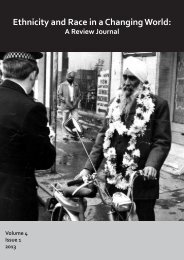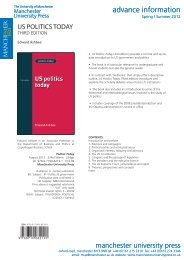<strong>Ethnicity</strong> <strong>and</strong> <strong>Race</strong> <strong>in</strong> a Chang<strong>in</strong>g <strong>World</strong>: A Review JournalThe same sentiment was expressed <strong>in</strong> the relationship between the IS/SWP <strong>and</strong> the Asian YouthMovements. The IS/SWP celebrated the creation of the Southall Youth Movement as the ‘<strong>in</strong>evitableconclusion to the spontaneous youth movement’ that emerged from the anger aga<strong>in</strong>st the racistattacks occurr<strong>in</strong>g at the time, which was <strong>in</strong>dependent of any leftist <strong>in</strong>tervention. 55 John Rose wrote<strong>in</strong> International Socialism that the formation of the SYM ‘took the entire local left by surprise’, writ<strong>in</strong>gthat they had ‘already given chase to the racists on the streets… <strong>and</strong> ultimately they will give theracists chase <strong>in</strong> the factories’. 56 However the IS/SWP felt that the ‘only long-term chance that theSYM has for growth <strong>and</strong> development is if the leadership comes to decisively adopt revolutionarysocialist politics’. 57The AYMs experienced difficulties <strong>in</strong> ma<strong>in</strong>ta<strong>in</strong><strong>in</strong>g their own identities when deal<strong>in</strong>g with the left, withthe leftist groups often depict<strong>in</strong>g the AYM campaigns as unorganised <strong>and</strong> lack<strong>in</strong>g leadership. BalrajPuriwal, expla<strong>in</strong>ed:Every time we tried to protest <strong>and</strong> give our own identity the left tried to take it over… they gaveus their slogans <strong>and</strong> placards… our own identity was subsumed, diffused <strong>and</strong> deflected. 58There was sympathy for the left amongst those <strong>in</strong>volved <strong>in</strong> the AYMs, but not at the substitution oftheir own identity. As Nermal S<strong>in</strong>gh wrote:The white left tell us only the work<strong>in</strong>g class as a whole will be able to smash racism byoverthrow<strong>in</strong>g capitalism <strong>and</strong> sett<strong>in</strong>g up a socialist state.This maybe so, but <strong>in</strong> the meantime are we, as one of the most oppressed sections of thework<strong>in</strong>g class, to sit by idly <strong>in</strong> the face of mount<strong>in</strong>g attacks. No! We must fight back aga<strong>in</strong>st thecancerous growth of racism. 59Tariq Mehmood, part of the AYM <strong>in</strong> Bradford, expressed a similar critique about the <strong>in</strong>terventionisttendencies of the organised left <strong>in</strong> the political actions of black youth, ‘I wanted a socialist world…[but what] I understood by socialism… [were] th<strong>in</strong>gs different to my white colleagues’. 60While the left, radical black activists <strong>and</strong> black youth cont<strong>in</strong>ued to <strong>in</strong>teract with each other, to vary<strong>in</strong>gdegrees, throughout the late 1970s <strong>and</strong> early 1980s, this already tenuous relationship became morefractured after the 1979 General Election, as the left’s anti-fascist campaign, which had brought thegreatest amount of <strong>in</strong>teraction between the left <strong>and</strong> Brita<strong>in</strong>’s black communities, decl<strong>in</strong>ed after theelectoral defeat of the National Front. Although the explicit fascism of the National Front had beencurtailed, racism was still a widespread phenomenon <strong>in</strong> British society. Brita<strong>in</strong>’s black communitiesstill faced many problems – harassment by the police, much higher unemployment rates under theConservatives, cont<strong>in</strong>u<strong>in</strong>g racial discrim<strong>in</strong>ation <strong>in</strong> the workplace, hous<strong>in</strong>g <strong>and</strong> social services <strong>and</strong>further restrictions on citizenship under the 1981 British Nationality Act. But most of the British left,already demoralised by the electoral victory of Thatcher <strong>and</strong> the amount of trade unionists whovoted Conservative, seemed to focus on the dist<strong>in</strong>ctly class-orientated aspects of Thatcherism <strong>and</strong>promoted a traditional <strong>and</strong> <strong>in</strong>dustrial-based response. That is, until the summer of 1981, when riotsbroke out across the <strong>in</strong>ner cities of Brita<strong>in</strong>.The 1981 Riots as Social ProtestThe first term of Margaret Thatcher’s Prime M<strong>in</strong>istership saw extensive riot<strong>in</strong>g by black youth, first <strong>in</strong>Bristol <strong>in</strong> 1980, then <strong>in</strong> Brixton <strong>and</strong> across Brita<strong>in</strong> <strong>in</strong> 1981. For commentators, academics <strong>and</strong> activistson the left <strong>and</strong> with<strong>in</strong> the black communities, these riots have been viewed as either part of a widermalaise by the lower classes aga<strong>in</strong>st the neo-liberal policies of Thatcherism, or the unstructured22
<strong>Ethnicity</strong> <strong>and</strong> <strong>Race</strong> <strong>in</strong> a Chang<strong>in</strong>g <strong>World</strong>: A Review Journalreaction by black youth to years of racial harassment <strong>and</strong> discrim<strong>in</strong>ation that cont<strong>in</strong>ued on from theblack struggles of the 1970s.For the left, the 1981 riots were <strong>in</strong>dicative of a widespread antipathy towards the socio-economicpolicies of the Conservative Government, which saw a reaction by the ‘most oppressed group <strong>in</strong> the<strong>in</strong>ner city areas’ – black youth – who ‘drew <strong>in</strong>to the struggle the slightly less oppressed’ – white youth. 61The Communist Party stated that the riots were ‘explosive’ reactions to long term problems <strong>in</strong> the <strong>in</strong>nercities, the ‘deep crisis affect<strong>in</strong>g [the economy] s<strong>in</strong>ce the 1970s <strong>and</strong> the ‘particular consequences ofThatcher’s policies’. 62 As black youth were amongst the most affected by these economic conditions,coupled with the more immediate burdens of police harassment <strong>and</strong> the impact of <strong>in</strong>stitutional racism,they were the most likely to react, albeit <strong>in</strong> a manner that was outside the organisation of the left.As the CPGB stated, ‘Anarchically – yes. Negatively – yes. Individualistically – yes. But nonetheless <strong>in</strong>struggle’. 63The SWP were adamant that the 1981 riots were ‘class riots’ <strong>and</strong> not ‘race riots’. 64 Col<strong>in</strong> Sparks statedthe riots were the work of ‘a ma<strong>in</strong>ly work<strong>in</strong>g class community aga<strong>in</strong>st the symbols of oppression <strong>and</strong>deprivation’. 65 The riots were the ‘common result of unemployment <strong>and</strong> crisis’, exacerbated by theexperience of racism <strong>and</strong> the unequal distribution of economic hardship upon black youth. 66 Whatdemonstrated the class aspect of the riots was, Chris Harman wrote, the fact that ‘<strong>in</strong> virtually all theBritish riots there has been significant white <strong>in</strong>volvement alongside blacks, <strong>and</strong> the <strong>in</strong>volvementhas not just been of white leftists, but of white work<strong>in</strong>g class youth’. 67 For Harman, the ‘immediatebackground of the riots lies… <strong>in</strong> a huge <strong>in</strong>crease <strong>in</strong> unemployment’, 68 with the result be<strong>in</strong>g a commonexperience of repression <strong>and</strong> economic hardship that contributed to the lower class rebellion. Harmanportrayed the riots as a modern <strong>in</strong>carnation of previous rebellions by the lower classes <strong>in</strong> Brita<strong>in</strong>. Whilethere was a strong narrative of resistance flow<strong>in</strong>g from the black <strong>in</strong>dustrial struggles of the 1970s<strong>and</strong> the disturbances at Nott<strong>in</strong>g Hill <strong>and</strong> Bristol, Harman l<strong>in</strong>ked the riots to previous unemploymentstruggles <strong>in</strong> 1886-87 <strong>and</strong> <strong>in</strong> 1931-32. 69 For the left, the riots were seen as a start<strong>in</strong>g po<strong>in</strong>t for resistanceto Thatcherism. The SWP declared that the riots were the symptoms of a ‘bitterness brew<strong>in</strong>g… fromthe experience of Tory government <strong>and</strong> economic crisis’, which would ‘sooner or later… explode <strong>in</strong>the factories as well as on the streets’. 70 It was up to socialists to ‘seize the opportunities to buildunity <strong>in</strong> struggle’ 71 that would present themselves as Thatcherism emboldened its attacks upon the‘subversive’ elements of society.While not deny<strong>in</strong>g the common economic causes of the riots or the <strong>in</strong>volvement of white youth,black activists <strong>and</strong> journalists emphasised the role of black youth <strong>and</strong> the racial discrim<strong>in</strong>ation <strong>and</strong>harassment experienced by the black communities that were <strong>in</strong>tegral factors <strong>in</strong> the outbreak ofthe riot<strong>in</strong>g. For the journal <strong>Race</strong> & Class, the reasons for the riots were clear, quot<strong>in</strong>g a black youth<strong>in</strong>terviewed for the Sunday Telegraph: ‘It is not aga<strong>in</strong>st the white community, it’s aga<strong>in</strong>st the police’. 72The journal emphasised the repressive nature of the police <strong>and</strong> the cont<strong>in</strong>ual harassment faced byblack people <strong>in</strong> everyday life. The repeated harassment by the police formed a long narrative thatheightened with the events of the late 1970s, before explod<strong>in</strong>g with the riots of the early 1980s. Thejournal tried to emphasise the cont<strong>in</strong>uity between the events, stat<strong>in</strong>g, ‘In many ways what happeneddur<strong>in</strong>g <strong>and</strong> after the 1976 Carnival was a premonition of the later “riots”’. 73The journal also drew a historical cont<strong>in</strong>uity between the hundreds of racial attacks that had occurreds<strong>in</strong>ce the mid-1970s - a process through which black people were ‘attacked,… crim<strong>in</strong>alised… <strong>and</strong>rendered second-class citizens’ - <strong>and</strong> the riot<strong>in</strong>g. Such riots represented a violent response aga<strong>in</strong>stthe racists <strong>and</strong> the police, who had failed to adequately protect the black communities. 74 Quot<strong>in</strong>g theHackney Legal Defence Committee, the journal portrayed the riots as the long awaited reaction tothis cont<strong>in</strong>ual racism:23






